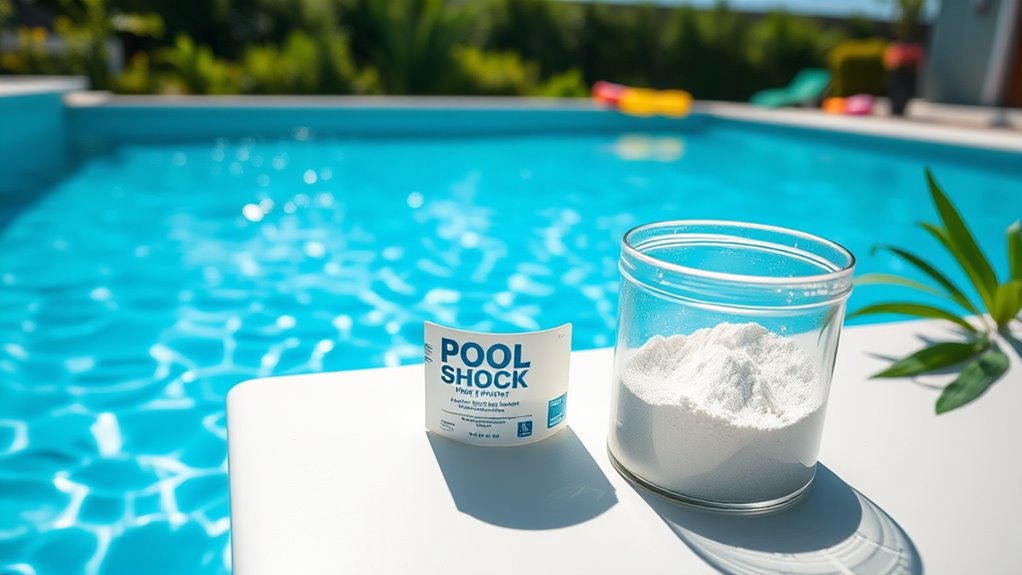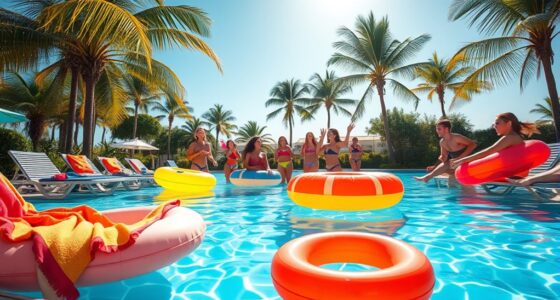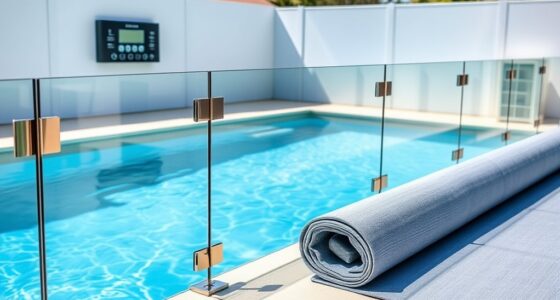Pool shock is a powerful chemical treatment used to disinfect and clarify your pool by destroying bacteria, algae, and organic contaminants. You should shock your pool when the water appears cloudy, has algae growth, or smells strongly of chlorine. To use it, test the water, remove debris, and add the shock evenly during evening hours. Proper handling and timing guarantee safety and effectiveness. Keep going to discover detailed steps and safety tips to keep your pool crystal clear.
Key Takeaways
- Use pool shock when water appears cloudy, has algae, or smells strongly of chlorine to disinfect and clarify.
- Choose the appropriate shock type based on pool chemistry, sunlight exposure, and contamination level.
- Dissolve or apply shock during evening or nighttime to minimize sunlight degradation and maximize effectiveness.
- Run the pool pump for at least 8-12 hours after shocking, then test chlorine levels before swimming.
- Always wear proper safety gear and store chemicals properly to ensure safe handling during shocking.
Understanding the Different Types of Pool Shock

Are you confused about which type of pool shock to use? There are several options, each with its own purpose. Calcium hypochlorite shock is the most potent, containing 65-75% available chlorine, perfect for heavy contamination or algae. However, it raises calcium hardness and pH levels, so avoid using it in saltwater pools. Sodium dichlor shock is stabilized, dissolves slowly, and contains cyanuric acid to protect chlorine from UV rays; it’s ideal for routine maintenance. Potassium monopersulfate is a non-chlorine, oxygen-based shock that quickly oxidizes contaminants, allowing swimmers to re-enter in about 15 minutes. Finally, sodium hypochlorite, or liquid bleach, provides rapid chlorine boosts but with less concentration and shorter shelf life. Choosing the right shock depends on your pool type, maintenance needs, and chemical balance. Understanding how each chemical interacts with your pool’s chemistry can help you select the most effective shock treatment for your situation. Additionally, considering the impact on water chemistry can ensure safe and effective pool maintenance.
Signs That Your Pool Needs Shocking
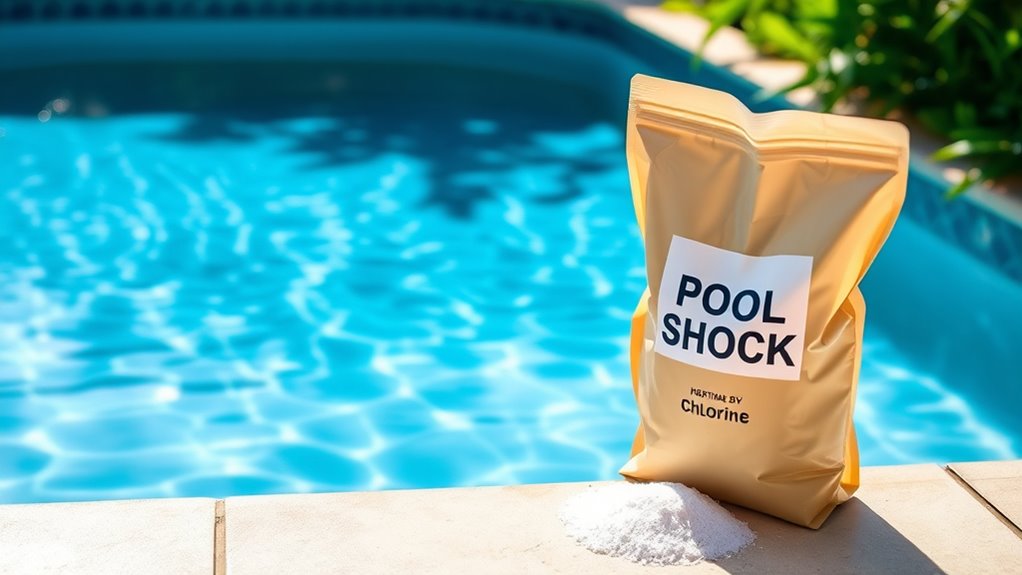
Knowing when your pool needs shocking is essential to maintaining clean, safe water. If you notice cloudy or murky water, bacteria and microorganisms are likely thriving, despite existing chlorine levels. Visible algae in green, yellow, or black spots signals an imbalance that requires shocking to restore clarity. A strong chlorine smell often means chloramines have built up, which need breaking down through shocking. If your eyes feel irritated or red during swimming, chloramine levels may be high, indicating shock is needed. Unpleasant musty or chlorine odors also suggest contamination. Additionally, after heavy use, storms, or hot weather, shocking helps eliminate accumulated contaminants, algae, and organic matter. Monitoring these signs keeps your pool safe, clear, and enjoyable throughout the season. Regular testing of water chemistry also plays a crucial role in detecting imbalances before they become visible issues, and understanding water chemistry can help you better respond to these signs.
Step-by-Step Guide to Applying Pool Shock
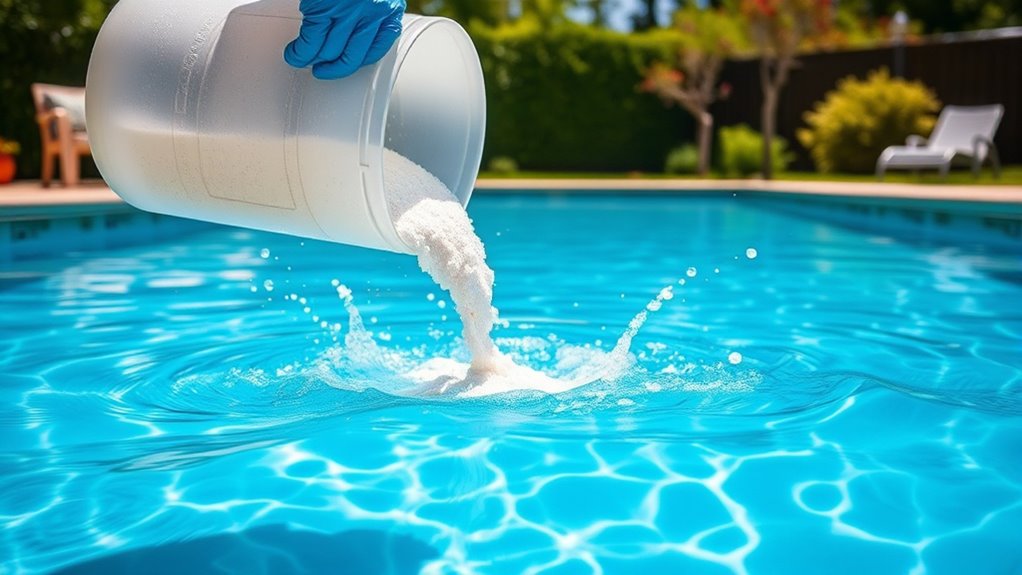
To properly apply pool shock, you’ll start by preparing the water to guarantee the treatment works effectively and safely. Next, you’ll distribute the shock evenly and carefully, following the manufacturer’s instructions. Afterward, you’ll need to monitor and maintain the water to keep it clean and safe for swimming. Balancing water chemistry is crucial before shocking to ensure that chlorine levels can effectively sanitize the pool. Ensuring the AI safety measures are in place helps prevent potential issues with automated or AI-driven pool maintenance systems.
Preparing Pool Water
Wondering how to guarantee your pool water is ready for shocking? Start by testing your water’s pH, aiming for 7.4–7.6, and check alkalinity levels between 80–120 ppm. Measure calcium hardness suitable for your pool type to prevent damage, and verify that cyanuric acid levels are within the recommended range. Also, test Free Available Chlorine (FAC) to determine whether you need a non-chlorine or chlorine shock. Next, remove all debris—leaves, dirt, and organic matter—to prevent chemical waste and ensure proper shock distribution. Clean your pump and filter, and brush surfaces gently if needed. Avoid adding shock directly onto pool surfaces to prevent damage. Proper preparation guarantees your shock treatment is effective and your pool water is safe for swimming afterward. Understanding pool water chemistry is essential to achieve optimal shock results and maintain a healthy swimming environment.
Applying Shock Properly
Applying pool shock correctly guarantees your water is sanitized effectively and remains safe for swimming. First, verify your pool’s pH, alkalinity, calcium hardness, and cyanuric acid levels are balanced. Wear gloves and goggles to protect yourself from chemicals. Gather all supplies, including the shock product, a clean bucket, and a stirring tool. Confirm your pump and filter are running before applying. If your shock requires dissolving, add it slowly to warm water while stirring continuously. For direct application, pour the dissolved or dry shock evenly around the pool’s perimeter in an “S” motion, focusing on edges and deep areas. Apply during evening or night hours to reduce sunlight degradation. Keep the pump running for at least 6-12 hours afterward, and test chlorine levels before swimming. Proper handling is crucial to avoid chemical mishaps and ensure effective sanitation.
Post-Shock Maintenance
After shocking your pool, maintaining proper water circulation and filtration is essential for ensuring the chemicals are evenly distributed and contaminants are removed. Run your pump and filtration system continuously for at least 8 to 12 hours to flush out residual chemicals and prevent algae growth. Regularly backwash or clean your filters to keep filtration efficient and support balanced water chemistry. Test your chlorine levels after 24 hours to confirm they’re within the safe range of 1.0–3.0 ppm, and monitor pH and alkalinity, adjusting as necessary. Skim debris, brush walls, and vacuum the pool bottom to remove organic matter and settled particles. Proper maintenance helps sustain water clarity and prevents the buildup of contaminants. Wait at least 24 hours before swimming, and always verify chemical levels are safe. Consistent maintenance preserves water clarity and protects your pool equipment.
Effects of Pool Shock on Water Chemistry
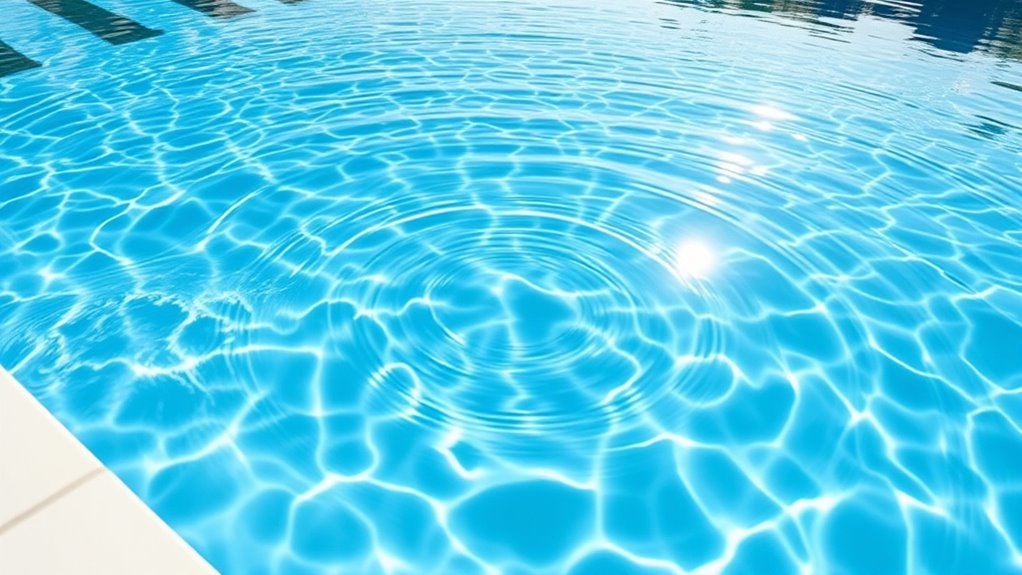
Pool shock markedly alters water chemistry by increasing free available chlorine (FAC) levels, which boosts disinfection and oxidation capabilities. Raising FAC to 10–30 ppm allows you to effectively destroy bacteria, algae, and chloramines, improving water clarity and safety. Shocking breaks down organic contaminants like sweat, oils, and urine, reducing chloramine levels that cause odors and irritation. Chlorine shocks also eliminate chloramines formed from organic waste, enhancing sanitizer efficiency. Some shocks, like cal-hypo and liquid chlorine, raise pH and alkalinity, requiring you to balance chemicals afterward. Non-chlorine shocks avoid pH changes, making them easier to manage. Pool shock also temporarily increases the water’s oxidation-reduction potential (ORP), which is a key factor in maintaining effective sanitation levels. Understanding water chemistry is essential for proper shock application and maintaining a healthy pool environment. Overall, shock treatment transforms water chemistry by reducing contaminants, enhancing sanitizer performance, and influencing pH, alkalinity, and hardness—all essential for maintaining healthy, clear pool water.
Pros and Cons of Various Shock Options
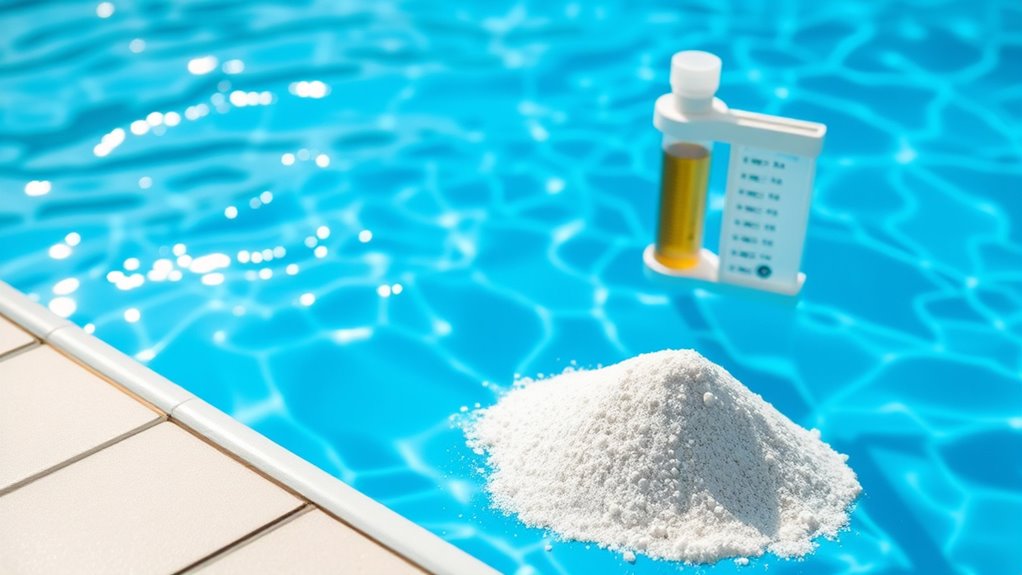
Choosing the right shock treatment depends on your pool’s specific needs and conditions. Each option has unique strengths and drawbacks:
- Calcium Hypochlorite (Cal-Hypo) offers high potency and fast algae and bacteria elimination but can raise pH and calcium hardness, risking scale buildup. Additionally, proper handling is essential due to its chemical potency and potential hazards.
- Sodium Dichlor provides stabilized chlorine, ideal for sunny pools, and maintains steady chlorine levels, though it increases cyanuric acid, which can affect water balance.
- Potassium Monopersulfate is chlorine-free, quick-acting, and safe for swimmers immediately after treatment, but it doesn’t sanitize directly and costs more.
Your choice depends on factors like pool type, sunlight exposure, and chemical balance. Weigh these pros and cons to select the best shock for your pool.
Safety Tips for Handling and Storing Pool Shock
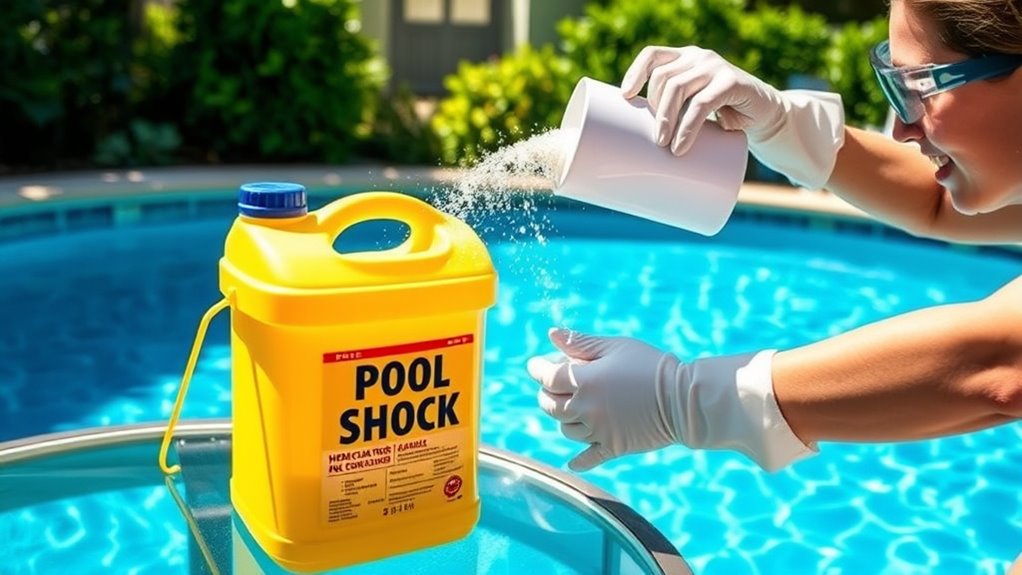
Handling and storing pool shock safely is vital to prevent accidents and guarantee your pool remains clean and safe. Always wear chemical-resistant gloves, safety goggles, and long sleeves to protect your skin and eyes from splashes and dust. Use a respirator or mask in poorly ventilated areas to avoid inhaling fumes. Store pool shock in a cool, dry, well-ventilated space away from sunlight, heat, electrical sources, and flammable materials. Keep containers tightly sealed and separate from food, drinks, and household chemicals. Follow manufacturer instructions carefully, adding shock slowly and avoiding mixing different chemicals. Handle chemicals outdoors or in well-ventilated areas, and ensure safety equipment like spill kits and emergency stations are accessible. Proper training and preparedness are essential for safe handling and storage. Proper storage reduces the risk of chemical reactions and accidental exposure, ensuring a safer environment for everyone.
Tips for Maintaining Balanced Pool Water Post-Shock

After shocking your pool, maintaining balanced water chemistry is essential to guarantee safety and clarity. Proper testing and adjustments help prevent issues like algae growth, cloudiness, or equipment damage. To keep your water balanced, focus on these key steps:
- Test and adjust pH, alkalinity, and calcium hardness regularly, aiming for pH 7.2-7.6, alkalinity 80-120 ppm, and calcium 180-220 ppm. This stabilizes water and maximizes shock effectiveness. Consistent testing ensures accurate readings.
- Run the pump and filter continuously for at least 8 hours, ensuring even distribution of chemicals and debris removal.
- Monitor chlorine residuals to confirm levels return to 1-3 ppm before swimming, and retest several hours later to verify water stability.
Consistent maintenance keeps your pool safe and inviting.
Frequently Asked Questions
Can I Use Pool Shock During the Day?
Yes, you can use pool shock during the day if you choose a stabilized chlorine shock like dichlor. It contains cyanuric acid, which helps protect the chlorine from UV degradation, making it effective in sunlight. Avoid unstabilized shocks like calcium hypochlorite, as sunlight rapidly diminishes their effectiveness. Just remember to wait until chlorine levels drop to a safe range before swimming, and retest water afterward.
How Often Should I Shock My Pool?
You should shock your pool based on usage and conditions, but generally, doing it weekly during peak season is a good rule of thumb. If your pool gets heavy use, shock after parties or storms, or if the water turns cloudy, it’s time to roll up your sleeves. Regular testing helps you stay ahead of problems, keeping the water crystal clear and safe for swimming. Don’t let things slide; stay on top of it!
Is It Safe to Swim Immediately After Shocking?
No, you shouldn’t swim immediately after shocking your pool. Chlorine levels are too high, which can cause skin and eye irritation, respiratory issues, and other health risks. You need to wait at least 8 to 24 hours if you used a chlorine-based shock, and verify the chlorine levels drop to 1-4 ppm. Test the water first, run your pump, and confirm safe levels before jumping in for a healthy, enjoyable swim.
Can Pool Shock Damage My Pool Liner or Equipment?
Yes, pool shock can damage your liner and equipment if you’re not careful—think of it as a chemical tantrum waiting to happen. Excessive chlorine levels or undissolved granules can cause liner wrinkling, bleaching, or cracking, while metal parts may rust faster. To avoid this chaos, always maintain proper chemical balance, pre-dissolve shock, and prevent direct contact with the liner. Your pool’s health depends on your chemical discipline!
What’s the Best Way to Remove Cyanuric Acid Buildup?
The best way to remove cyanuric acid buildup is by partial draining and diluting your pool water. You substitute the high-CYA water with fresh, clean water, effectively lowering the levels. While reverse osmosis can do this without draining, it’s costly and less practical for residential pools. Avoid chemical reducers, as their results are inconsistent. Regular testing and careful water management ensure your pool stays balanced and safe.
Conclusion
Think of pool shock as the spark that reignites your pool’s sparkle. When you understand the right time and method to use it, you keep your water crystal clear and inviting. Handle it with care, and your pool will be a invigorating oasis, shining brighter after every shock. With proper maintenance, you’ll turn your pool into a calm, sparkling lake—your personal retreat beckoning whenever you need it.

